Step-by-step instructions for growing dill in a greenhouse all year round
Dill is one of those greens that we enjoy eating all year round. The bright aroma of this plant is given by the essential oil contained in the stems, leaves and seeds. Fragrant branches are added to salads, first and second courses, used in winter canning, frozen, salted and dried. The fragrant seasoning is good in any form.
Unlike other types of greens, dill is surprisingly unpretentious. In summer it grows well both in sunny areas and in the shade, and in winter in greenhouse conditions. In this article we will tell you how to grow dill in a greenhouse and what nuances you should pay attention to.
Growing dill in a greenhouse all year round
Growing dill in a greenhouse is not a troublesome task. In protected soil it grows even in the harsh Siberian climate. To harvest a rich winter harvest, consider the following features:
- when planting dill in a greenhouse or hothouse in winter, the seeds are buried 1.5-2 cm into the ground;
- additional sowings are carried out every 2-3 weeks to ensure constant new shoots;
- Fertilizers are periodically applied to the soil;
- The soil in the greenhouse is regularly moistened and loosened.
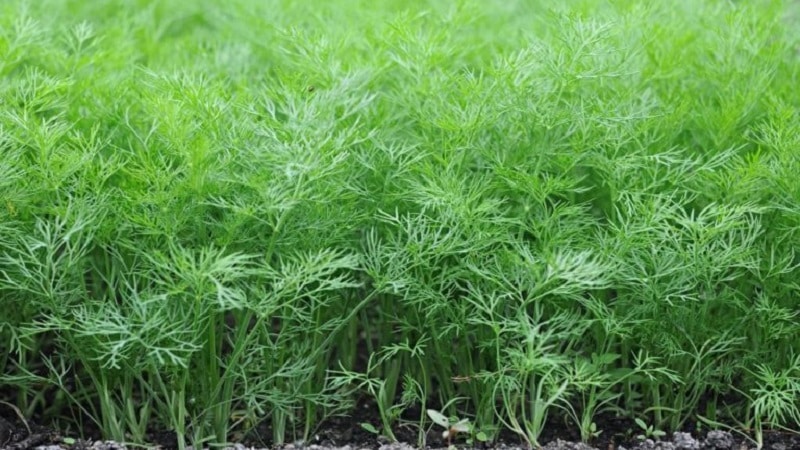
Dill is not picky about soil. Ordinary soil, sandy, and clayey are suitable for cultivation. But if you want to grow spices in large quantities, the soil should be prepared.
Interesting fact. Russian poet and writer Nikolai Nekrasov loved to season all the soups he ate with dill.
The dill bed is dug up in the fall and fertilized with humus. Before sowing, mineral fertilizers are applied. Dill grows well in neutral acid soil. When planted in alkaline soil, greens often get sick and develop poorly.
Dill in the greenhouse in winter planted in the ground only if the ground does not freeze in the cold months. Otherwise, the seeds are planted in deep boxes filled with soil. Holes for water drainage are made in advance in the boxes.
Important! With insufficient watering, dill begins to bloom. Because of this, the amount of useful greenery on the bush decreases.
In the greenhouse for dill keep the air temperature at least +15˚С. The soil is regularly moistened. For irrigation use only warm water.
Dill refers to light-loving plants. The lack of sun in winter is compensated by artificial lighting. The optimal length of daylight for greenery is at least 12 hours.
For reference. In winter, dill plantings in the greenhouse are given additional light. With a lack of light, the greenery will grow pale and the bushes will not be lush.
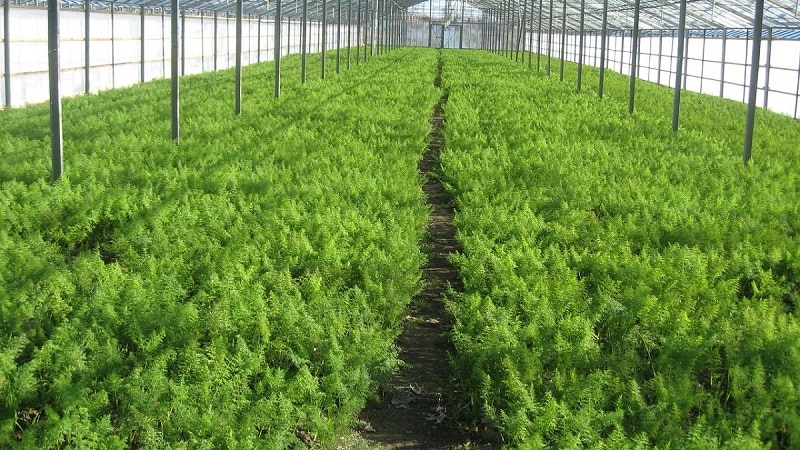
Suitable varieties
Success largely depends on the correct choice of seed material. It is better to give preference varieties of dillresistant to sunlight deficiency.
The varieties bred by Russian breeders are good for greenhouses: Anker, Almaz, Sevastopolsky, Umbrella, Grenadier, Karusel, Preobrazhensky, Iney, Max, Kutuzovsky. They grow quickly, produce a large amount of lush, fragrant greenery without unnecessary “florescence”.
According to the ripening period dill greens are divided into early-ripening, mid-ripening and late-ripening.
Early ripening varieties
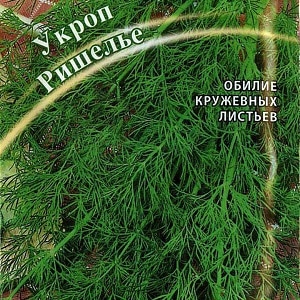 Early ripening varieties produce the first young greens within 35-45 days after seed germination.True, the bushes of early-ripening dill are not as lush as those of late-ripening ones. Also, early dill blooms quickly. Umbrellas appear after the formation of 4-6 leaves.
Early ripening varieties produce the first young greens within 35-45 days after seed germination.True, the bushes of early-ripening dill are not as lush as those of late-ripening ones. Also, early dill blooms quickly. Umbrellas appear after the formation of 4-6 leaves.
Early dill It is advisable to grow to obtain the first greenery in the spring, for collecting seeds and umbels for canning. For cultivation in greenhouses in winter, it is better to choose mid- or late-ripening varieties.
Popular early varieties include Redut, Richelieu, Grenadier, Dalniy, Gribovsky.
Attention! Early dill forms an inflorescence immediately after the formation of the stem. No more than 4-6 leaves are formed on the bush.
Mid-season varieties
In varieties of this group stem formation occurs 45-50 days after emergence. A large amount of greenery is formed on dill bushes - up to 10 leaves.
Important! Mid-season varieties allow you to harvest a substantial harvest of greenery in a short time.
This group optimally suited for commercial cultivation dill greens in protected ground. Among the mid-season varieties, such as Amazon, Abundant-leaved, and Umbrella are known.
Late ripening varieties
These varieties are distinguished by a powerful, well-leafed rosette. There are more than ten leaves on the stem. Due to the close proximity of internodes, late varieties are also called bush varieties.
Important! Late varieties give maximum yield, but you will have to wait two months or more for it. It takes 55-75 days from sowing the seeds to harvesting the first harvest.
Growing late dill in equipped greenhouses allows you to harvest fresh herbs all year round.
Popular late varieties include Buyan, Alligator, Patterns, Kibray, Salute.
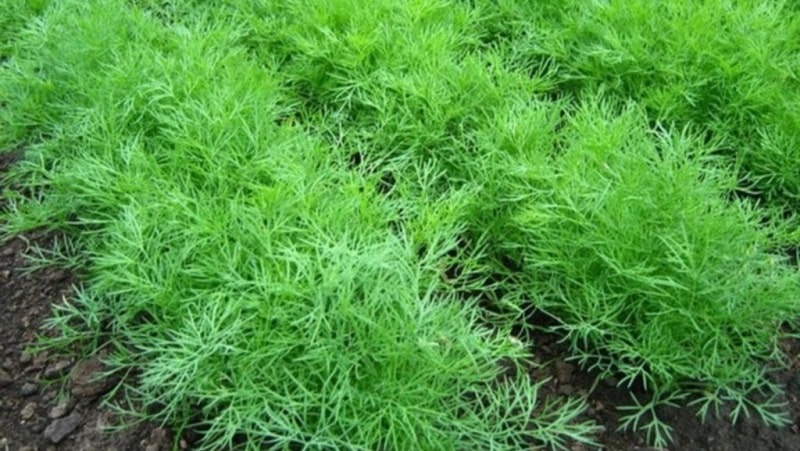
The necessary conditions
Before you start growing dill in a greenhouse in winter, certain conditions are created in it.
The first is temperature.The minimum temperature required for green growth is +15˚С, the optimal temperature is +20˚С. If it gets cold at night, the plants will die.
Advice. Install a thermometer in the greenhouse and check the readings day and night.
Heaters are used to maintain temperature. This option is suitable for a greenhouse or polycarbonate greenhouse.
A more affordable option – periodically water the ground under the boxes with boiling water. In a small building, containers with hot water are additionally installed. They warm the air well. At night, the greenhouse is covered with insulating material to reduce heat loss.
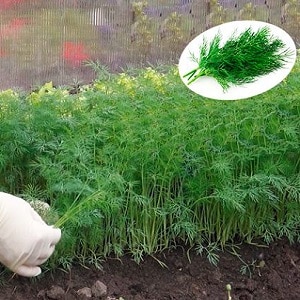 For rapid growth, dill needs not only warmth, but also light.. The culture needs long daylight hours. In winter, it gets dark earlier and gets light later, so the lighting is artificially extended by 6-7 hours.
For rapid growth, dill needs not only warmth, but also light.. The culture needs long daylight hours. In winter, it gets dark earlier and gets light later, so the lighting is artificially extended by 6-7 hours.
The lamps are turned on three hours before sunrise and another three hours after sunset. Light is used from incandescent lamps or daylighting. Lamps are placed at a distance of 50 cm from the plants. A gap of 1 m is maintained between them.
In winter, dill is not grown in open ground. Despite warming up, the possibility of soil freezing in frosts remains. Use boxes with a depth of at least 20 cm. They are filled with soil and placed on shelves or tables. Holes are made at the bottom to drain excess water and ventilate the root system of plants.
It can be useful:
Instructions for growing dill in a greenhouse
The technology for growing dill in greenhouse conditions consists of several stages.
Preparatory stage
First stage consists of preparing the soil and seed material. Dill grows well in fertile, light soil.The prepared containers are filled with soil mixed with humus and mineral fertilizers.
Seeds are prepared shortly before sowing. First, they are disinfected in a solution of potassium permanganate, then washed in clean water and soaked for several days.
Attention! Dill seeds are covered with a protective layer of essential oil. Soaking before planting weakens it and improves germination.
Correct fit
The prepared boxes are filled with soil. Before sowing the seeds, the soil is well moistened and leveled. On the surface of the soil, make grooves 2 cm deep, maintaining 20 cm between rows. The soaked seeds are laid out in them and sprinkled with loose soil, compacting it a little. Do not water the crops, otherwise the seeds and water will go deeper into the soil than necessary.
Further care
Further care for dill plantings consists of: regular watering, loosening the soil and removing weeds, applying fertilizers.
Water dill with warm water. Before the first shoots appear, it is important to ensure that the soil does not dry out. After watering, the soil is loosened, removing weeds along the way.
When growing dill both indoors and outdoors, it is important not to forget about timely application of fertilizers. Spicy greens grow quickly, so fertilizing is applied when preparing the soil or before sowing seeds directly into the furrows. Superphosphate or “Nitrophoska” is used as fertilizer.
Possible difficulties
Dill is an unpretentious crop, but difficulties can arise with it.. They are associated with damage to plantings pests and diseases. Let us consider them in more detail, as well as methods of prevention, control and treatment.
Powdery mildew
The cause of infection is a fungus that spreads in greenhouses due to weeds. It overwinters on plant debris, weeds and wild umbellifers.
The first sign of the disease is a white coating that contains spores. In advanced cases, the fungus spreads to all above-ground parts of the plant. Affected greens lose their taste and aroma.
If a problem is detected, the affected parts of the bush are removed. The remaining plants are sprayed with potassium permanganate, copper-containing preparations or a mixture of antibiotics Terramycin, Penicillin and Streptomycin in equal proportions.
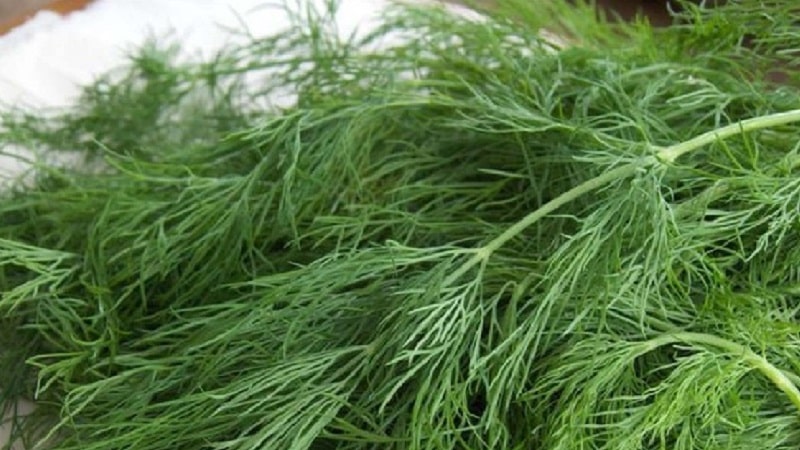
Dill rust mushroom
The disease manifests itself in the form of brown-yellow spots. For prevention, seeds are soaked in hot water before planting. Then cool in cold water and dry. The disease is treated by spraying with 1% Bordeaux mixture three times a month.
Downy mildew
The fungus develops on the foliage and stems of dill in a moist, warm environment.. The outer side of the foliage, umbrellas and shoots turns yellow and then darkens. A whitish coating appears on the reverse side. The disease spreads through infected tops, seeds and weeds.
Peronosporosis is treated by spraying with a 1% solution of colloidal sulfur or a solution of soda and soap (20 g of soap and 25 g of soda per 5 liters of water). As a preventative measure, the beds are sprayed with 1% Bordeaux mixture.
Aphid
These are the main pests of dill. Helps fight them spraying with infusions of tomato and potato tops with the addition of laundry soap.
Umbrella moth
In case of umbrella moth infestation, dill is dug up and burned.. The pest eats dill seeds, entwining the buds. As a preventive measure, wild umbrella plants on which parasites live are removed from the area.
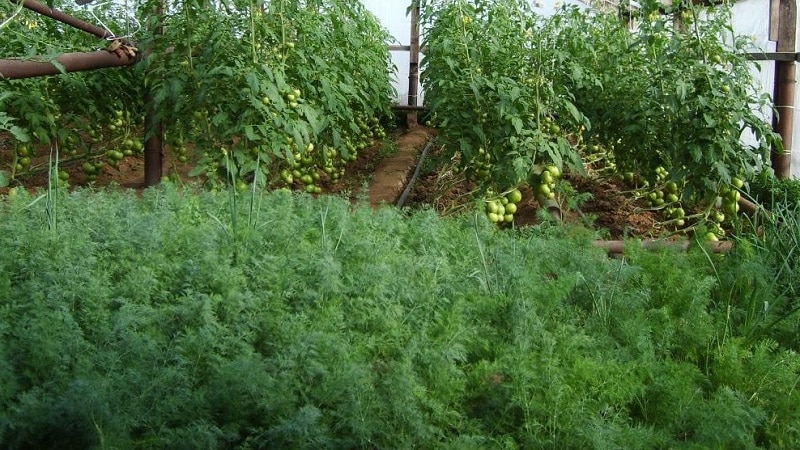
Harvest and storage
Dill produces excellent seed material. Depending on the variety grown, the seeds ripen in July-September. The readiness of the seed harvest is judged by the color of the umbrellas. When they turn brown, dry and harden, start collecting.
The inflorescences are cut off, leaving a part of the stem about 10 cm long. Umbrellas are collected in bunches, tied and dried in a dry, dark place. It is recommended to hang the bunches on threads with the inflorescences facing down.
Year-round cultivation of dill in a greenhouse as a business
For owners of one or more greenhouses growing spicy herbs for sale is a good investment option. With the right approach, this type of business brings tangible returns with minimal resources.
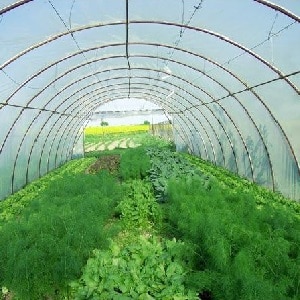 Success of growing dill for commercial purposes due to the following factors:
Success of growing dill for commercial purposes due to the following factors:
- fresh herbs are in demand all year round;
- the cost of young greenery is high, from late autumn to early spring;
- the culture is unpretentious;
- dill is resistant to diseases and pests;
- for commercial cultivation, you can use a greenhouse in your own garden that is empty in winter;
- starting a business requires minimal investment.
There are many positive aspects. But it is worth assessing the difficulties. Firstly, cut greens do not last long. Secondly, in winter, plants need to be provided with additional lighting. And thirdly, in cold weather the greenhouse needs to be heated.
Conclusion
Dill is a healthy and tasty herb that perfectly complements the taste of various dishes. In winter, the spice is easy to grow in a greenhouse. The main thing is to provide the plants with enough light and heat. With the right approach, cultivating dill in protected soil can easily be turned into a profitable business.